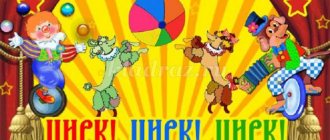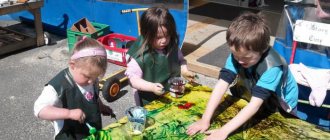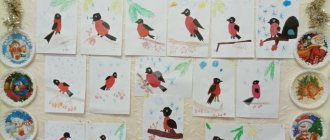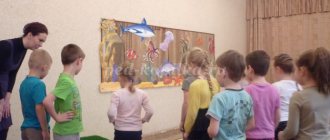Integrated and comprehensive classes
Integrated learning allows you to see and understand any phenomenon holistically; in kindergarten there is a subject-based learning system and it often turns out that knowledge remains scattered, artificially divided according to the subject principle, and as a result, children do not always holistically perceive the whole picture of the world around them.
Integrated classes are a combination of several types of activities. Complex classes within the framework of one topic solve different problems of children's development and are based on different types of activities. These classes can be carried out in all age groups, but they are especially useful with older preschoolers.
The section of the site, integrated and comprehensive classes in kindergarten for different groups, contains many interesting publications for educators on teaching children on various topics:
- Scenario for an integrated lesson in kindergarten
- Integrated lesson on application and ecology in kindergarten
- Summary of an integrated educational activity in kindergarten with children 3-4 years old
- Summary of an integrated educational activity with children 2–3 years old in kindergarten
- Lesson summary for younger children integrated lesson in junior group 2
- Synopsis of the integrated GCD preparatory group of kindergarten
- Summary of GCD in kindergarten
- Summary of an integrated lesson in the middle group of kindergarten
- Summary of an integrated lesson for Victory Day in kindergarten
- Summary of an integrated lesson in kindergarten with children of senior preschool age
- Summary of integrated organized educational activities
- Summary of an integrated lesson on cognitive-speech and artistic-aesthetic development of children in the second junior
- Integrated lesson in the preparatory group
- Summary of an integrated lesson on the Russian language and the surrounding world for a preparatory school group
- Integrated open lesson with children of the preparatory group
- Summary of an integrated lesson for the middle group of kindergarten
- Integrated open lesson
- Integrated lesson for the middle group
- Open integrated lesson on speech development, the environment and mathematics in the preparatory group of kindergarten
- Summary of an integrated lesson on ecology and speech development, senior mixed-age group
- Summary of integrated OOD in the senior group
- Summary of integrated OOD in the preparatory group
- Summary of an integrated lesson in kindergarten
- Summary of the final integrated lesson in the first junior group
The most important thing in integrated classes in a preschool educational institution is the unity of goals, understanding of the techniques, methods, tasks that determine the harmonious development of the child’s personality, in other words, the ability to “crawl”, “enter” the pedagogical process, without creating stress for children, literally physically reducing to level of their eyes and focusing, in organizing their work, on their right-hemisphere characteristics. A fundamentally important point in organizing integrated classes in preschool educational institutions will be the activation of all mental processes that ensure successful learning.
The modern direction of development of the educational system has affected all kindergartens in the country without exception. Now integrated classes in preschool educational institutions are considered popular and most effective. The Ministry of Education approves and encourages the comprehensive development of students, as evidenced by a number of recommendations from the Federal State Educational Standard. What are integrated classes? In general, training according to a similar principle involves the simultaneous development of the child.
Integrated lesson in kindergarten - combines knowledge from various educational fields, on an equal basis, complementing each other (for example: the concept of “autumn” is considered through the means of music, art, painting, ecology). At the same time, in such a lesson, the teacher solves several development problems.
An integrated lesson is an activity that is aimed at revealing the holistic essence of a certain topic through different types of activities, which are combined in the broad information field of the lesson through mutual penetration and enrichment.
open integrated lesson “By playing we develop”
Lesson notes
Integrated lesson for older children
“By playing, we develop”
Target
: consolidate acquired knowledge; children’s ability to develop children’s communication skills with peers in play, to form children’s ideas about the meaning of relationships.
Equipment:
keys, red and yellow medals (according to the number of children), a chest, a labyrinth, pictograms-emotions, a plan map, 2 letters from the Invisible Gnome and Shapoklyak, a surprise moment - an educational game.
Hello dear guests parents and children.
We would like to show an open integrated lesson together with a psychologist, a group teacher and a physical teacher.
Progress of the lesson
“Without play there is not, and cannot be, full mental development. A game is a huge window through which a life-giving stream of ideas and concepts flows into the child’s spiritual world.
Play is the spark that ignites the flame of inquisitiveness and curiosity.”
V.A. Sukhomlinsky.
While playing, a child can acquire new knowledge, skills, and abilities, without even realizing it.
Guys, look out the window and tell me what the weather is like today? (cloudy)
What mood does cloudy weather bring to a person? (sad, sorrowful, dreary)
What does a person do in such a mood? (bored, frowns, sometimes cries)
So that a gloomy mood does not settle in our kindergarten in our hall, I suggest holding hands and saying hello, calling each other affectionate names and shaking hands.
What's your mood now?
You probably felt the warmth of your friends’ hands and your mood improved.
Look, the room has become light and joyful, cozy from your smiles.
How else can you say about a good mood (kind, cheerful, warm, affectionate, joyful).
Today we received a letter at our kindergarten and it is addressed to the children of your group. Let's read it.
Letter!!!
“Hello, my name is Gnome. I can be invisible. When I come to your classes where you play, you don’t see me. I know that you are smart, hardworking, love to solve riddles, solve problems, draw, and do physical education. Therefore, I decided to give you an “educational game……………”, but the cunning old woman Shapoklyak hid it in a chest. She closed the chest and hid the key to it with other keys. Only you can find the chest and open it. I am sending you a plan to find the chest. Be careful: difficulties await you. If you overcome them and collect 5 keys, you will receive a gift from me.
"Good luck".
Your Gnome.
It's a difficult task! Really, guys!!!
What do you think: it’s worth trying to find an “educational game……………”. Since you agree, then let's go; just let’s go on a fabulous journey not alone, but together with Irina Vladimirovna, because we can’t do it without her advice, and we can’t do without Olga Vladimirovna’s physical training.
Integrated lesson in an early age group. Abstract
Summary of an integrated lesson in kindergarten for children 2-3 years old “Journey through a magical forest.”
Children's age: 2-3 years. Audience: kindergarten teachers. Educational areas: social and communicative development, Speech development, Cognitive development, Physical development, Artistic and aesthetic development. Preliminary work: looking at illustrations and reading fiction about wild animals, conversations on the topic “wild animals”, “who lives where?”, learning finger games, dancing with carrots, playing with mushrooms and pine cones, modeling salt dough. Tasks by area: - To consolidate children's understanding of wild animals (name, who eats what and what? Where does they live?) - To consolidate the signs of spring. — Develop memory, thinking, perception. — Promote the development of children's vocabulary through play activities, fine motor skills and tactile sensations. - Give children joy and pleasure from joint activities. — Cultivate friendly relationships, a desire to help. — Cultivate interest in musical and creative activities. — Strengthen the ability to distinguish and name primary colors: red, yellow, green, blue. — Consolidate knowledge of sculpting techniques: rolling a ball between your palms in a circular motion. — Develop the skill of using salt dough carefully. — Create a friendly, emotionally rich atmosphere. Design: Magic forest. Material for the lesson. Toys: hare, squirrel, bear, sun, clearing with flowers, 2 baskets with mushrooms and nuts, salt dough Plot and course of the lesson. Organizational moment Educator: Guys, look, guests came to us today, let's say hello to the guests, smile at them and at each other. Educator: Guys, look who else came to visit us? Children: sunshine. Educator: - The sun came to visit us and invites us on a journey. And we will go on a trip on a train. Chug chug. (Music plays.) Well, here we are.
Educator: Guys, look at the path in front of us. Let's walk through it. And around, look, there is a forest. The sun is looking from the sky. Yes, how pure, kind, radiant. Educator: Guys, let's look at the sun, what is the sun missing? Children: Luchikov. Right. Educator: Let's decorate the sun with rays?
Educator: Look, children, how bright and beautiful the sun has become. Well done guys completed the task. Let's continue traveling through the forest. Educator: Look what’s on our trees? Children: leaves. Educator: What color are the leaves on the tree? Children: Green. Well done. Educator: when do our leaves bloom? Children: In the spring. Educator: Look, what kind of tree is this? Children: (Christmas tree) Educator: Guys, guess the riddle: She lives on the Christmas tree and gnaws nuts. Children: (Squirrel). Who is sitting on the branch? (squirrel) - Look, does the squirrel have eyes? Do you have eyes? Does a squirrel have a nose? Where is your nose? Does a squirrel have ears? Where are your ears? etc. children show body parts. I was jumping on the branches, collecting cones for the children, but the basket suddenly fell, I lost everything here. Help me guys. We need to help the squirrel sort nuts into one basket and pine cones into another basket. Educator: Oh, what great fellows, they coped with the task. Let's go further into the forest. Goodbye squirrel.
Educator: Look, guys, there’s a clearing in front of us, let’s sit down in the clearing. Look what flowers? The wind blew and all the butterflies flew away from the flowers, let's help the butterflies return to their flowers, you need to plant a butterfly on each flower in color. Well done. Let's go further into the forest. Educator: Guys, guess the riddle: He jumps deftly, loves carrots. (bunny). Educator: Oh, who’s sitting here? Children: A hare is sitting under a stump. Educator: do you know a poem about a bunny? A poem by A. Barto is recited: “The Mistress Abandoned the Bunny.” Well done boys . Why is our bunny sad? Let's have fun with the bunny and dance the "carrot dance." We give carrots to the bunny. Thanks guys for the carrots. Goodbye bunny! Educator: Let's go further into the forest. Educator: Let's guess the riddle: He lives in a forest thicket, He loves raspberries and honey. (Bear).
Educator: Oh, look who’s waiting for us here. Children: Bear. Let's act like bears. The children repeat after him. Educator: “The clumsy bear is walking through the forest.” The children repeat after him. Educator: Guys, let's bake gingerbread for the bear. The bear will be very happy! Children: yes. Educator: To bake gingerbread cookies, you need to take the dough (demonstration). I take the dough in my hands, I remember the dough now. Like this, like this, I mold a round ball. Like this, like this (roll out the ball in a circular motion) And now I’ll press the ball, press very, very hard, it’s a round gingerbread, I’ll treat the bear with something sweet. Children make gingerbread cookies. The teacher helps children if necessary. Educator: Place the gingerbread cookies in plates. Well done boys! We baked beautiful gingerbread cookies, the bear will love them.
Bear: And here are the guys and you have a treat from me. Eat for your health. Goodbye bear. We walked in the forest, saw all the beauty, and now it’s time to say goodbye and return to our group. Educator: Do you hear, guys? (the train signal sounds) Who drove up behind us? (Children's response) Children imitate the movements of the train and leave. Reflection summing up.
We recommend watching:
Integrated lesson with children of the first group of early age Synopsis of educational activities in the 1st junior group on familiarization with the outside world. Visiting a fairy tale Technological map for organizing joint activities with children of the 2nd early group Synopsis of educational activities in the early age group with presentation
Similar articles:
Lesson notes for the 1st junior group of kindergarten. Introduction to clay
Lesson summary for an early age group. Getting to know the sun
Summary of a game development lesson in kindergarten in the second group of early age on the topic: Animals
Summary of a game lesson for children of the third year of life on the topic: Octopus
Summary of a game lesson for children of the third year of life on the topic: Clocks



